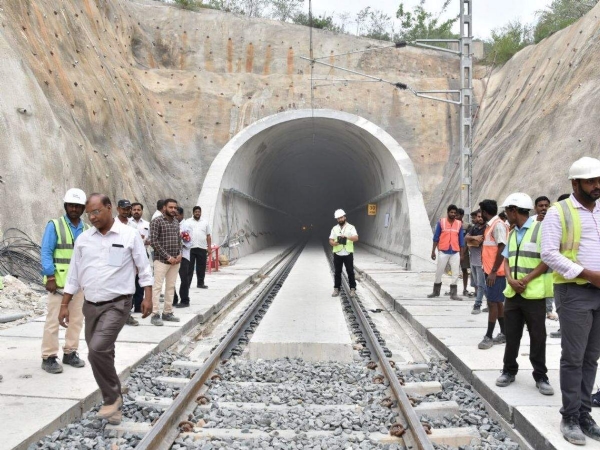Railways connects India's longest tunnel T-49 in Katra-Banihal section
T-49 is going to be the longest tunnel of Indian Railways, surpassing Peer Panjal Tunnel of 11.2 km length, constructed by USBRL.
Total Views |
Srinagar, February 17: The Indian Railways successfully achieved a breakthrough of the 12.758 kilometre long T-49 tunnel in Jammu and Kashmir. The major milestone connected the two ends of the tunnel between Sumber and Arpinchala stations of Katra-Banihal section of Udhampur-Srinagar-Baramulla Rail Link (USBRL) project.

The south portal of the tunnel is located at an altitude of 1400 metres, while its north portal is located at an altitude of 1600 metres.
The tunnel has been constructed using the New Austrian Tunneling Method (NATM), which is a modern technique of drill and blast method. The Northern Railway said that the cross section profile of the tunnel is modified horseshoe-shaped.
T-49 tunnel has two tubes - one is the main tunnel and other being escape tunnel. As per international standards, the escape tunnel being constructed parallel to the main tunnel is connected by cross passages at an interval of 375m to facilitate rescue and restoration work.
Out of 272 km length of USBRL project, 161 kilometres has already been commissioned and operationalised.
It added that many challenges were encountered in the course of construction such as shear zone, perched aquifer, and highly jointed rock mass, rock problems of squeezing and high ingress of water.

T-49 is going to be the longest tunnel of Indian Railways, surpassing Peer Panjal Tunnel of 11.2 km length, constructed by USBRL on the Banihal-Qazigund section, informed the Northern Railway.
Key points to know about T-49:
The south portal of the tunnel is located at an altitude of 1400 metres, while its north portal is located at an altitude of 1600 metres.
The tunnel has been constructed using the New Austrian Tunneling Method (NATM), which is a modern technique of drill and blast method. The Northern Railway said that the cross section profile of the tunnel is modified horseshoe-shaped.
Also Read | Nitin Gadkari inaugurates Munger Ganga Bridge worth Rs. 696 crore
The NATM is also known as the sequential excavation method (SEM). It uses the strength of the surrounding soil to the greatest extent possible to strengthen the tunnel structure. The NATM promotes constant monitoring.
T-49 tunnel has two tubes - one is the main tunnel and other being escape tunnel. As per international standards, the escape tunnel being constructed parallel to the main tunnel is connected by cross passages at an interval of 375m to facilitate rescue and restoration work.
Out of 272 km length of USBRL project, 161 kilometres has already been commissioned and operationalised.
Also Read | India's first Orthotropic Steel Deck launched in Mumbai
The work of the intervening stretch of 111 kilometre between Katra Banihal is under progress at rapid pace, said the railways.
It added that many challenges were encountered in the course of construction such as shear zone, perched aquifer, and highly jointed rock mass, rock problems of squeezing and high ingress of water.